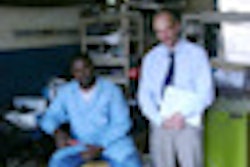Better staff training and quality control (QC) have helped 10 high-volume hospital radiology departments and medical imaging clinics in Iran cut patient radiation exposure by up to 62% for routine radiographic procedures.
Hamid Khosravi, PhD, and other medical physicists associated with the Iran Nuclear Regulatory Authority, Tehran University of Medical Sciences, and the Nuclear Science and Technology Research Institute of Tehran conducted the study at seven private hospitals and three medical clinics licensed by the Iranian central health authority.
Their results were presented as a scientific poster at the American Association of Physicists in Medicine (AAPM) and the Canadian Organization of Medical Physicists (COMP) 2011 joint meeting, held this month in Vancouver, British Columbia.
The research tracked the initial clinical impact of efforts in Iran to apply the European Guidelines on Quality Criteria for Diagnostic Radiographic Images (EUR 16260) to facilities. Radiographers were trained on the proper use and maintenance of quality assurance tools and the application of general x-ray dose optimization techniques for 12 routine radiological examinations.
Quality control lessons included the use of added filters for half-value layer (HVL) beam quality measurements for reducing entrance surface air kerma (ESAK). Training covered the use of suitable focus to patient entrance surface distance (FSD) and proper exposure parameters, especially kVp settings, to reduce ESAK, Khosravi said.
In the trial, ESAK was measured for each x-ray system before and after the implementation of QC measures and radiographer training at the 10 facilities.
The researchers found at minimum an average 22% ESAK reduction for each of the 12 x-ray applications. ESAK was reduced by at least 60% for posteroanterior and lateral chest procedures. ESAK fell 53% for lateral lumbar and lateral thoracic spine radiographs.
ESAK reduction by anatomical region
|
|||||||||||||||||||||||||||||||||||||||
| Source: Hamid Khosravi, PhD |
Khosravi credited the adoption of suitable FSD and proper exposure parameters, especially kVp settings, for the reduced radiation dose.
The findings suggest that better training and QC can increase the appropriate application of diagnostic techniques involving ionizing radiation, especially among the high-volume hospitals and clinics that handle most of the radiographic procedures performed in Iran.
"These kinds of departments have large numbers of patients, so any kind of optimization of the procedures will reduce diagnostic cumulative dose," he said.
The results will also help support lobbying efforts for the nationwide implementation of proposed national diagnostic reference levels (NDRLs) to regulate medical radiation protection in the country, he said. Khosravi and his colleagues developed the proposed standards.
"It's our long-term goal to use optimized NDRLs for diagnostic x-ray departments, which have considerable patient load," he said.



















